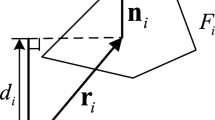Abstract
The interior potential of a spherical planetary body (and the corresponding density distribution) is expressed as the sum of two parts, the first given uniquely by the external gravity field and the surface density and the second depending on an arbitrary function. The first part of the potential (density distribution) is shown to be a 3-harmonic (biharmonic) function, while the second part can be expressed as a series whose i-th term (for i ≥ 0) is an (i + 4)-harmonic ((i + 3)-harmonic) function. From this general solution a single solution is then chosen: this is done by imposing certain natural conditions on it, among others that this particular solution is an n-harmonic function for n as small as possible.
The paper explains shortly this method of solving the inverse problem of gravimetry; details are presented in Pohánka (1993).
Similar content being viewed by others
References
Pohánka V., 1993: Inverse problem of gravimetry for a spherical planetary body. Geophys. Inst. Slov. Acad. Sci., Bratislava, pp. 204.
Author information
Authors and Affiliations
Rights and permissions
About this article
Cite this article
Pohánka, V. Solution of the Inverse Problem of Gravimetry for a Spherical Planetary Body Using the Decomposition of the Interior Potential into a Series of Polyharmonic Functions. Studia Geophysica et Geodaetica 41, 1–14 (1997). https://doi.org/10.1023/A:1023330805840
Published:
Issue Date:
DOI: https://doi.org/10.1023/A:1023330805840




